 |
Focus features two in-depth reviews each month of fine art, architecture and design exhibitions and events at art museums, galleries and alternative spaces around Japan. The contributors are non-Japanese art critics living in Japan. |
|
|
 |
 |
 |
La Dolce Vita in Nikko: The Former Italian Embassy Villa
Alice Gordenker |
 |
The Former Italian Embassy Villa on Lake Chuzenji, designed by Antonin Raymond in 1928. |
Ah, the charmed life of a Western diplomat at the turn of the 19th century. The glamour. The parties. The long summers passed leisurely in highland resorts. While that lifestyle may be long gone, it is still possible to enjoy a small taste of it -- and learn about modern Japanese architecture -- through a visit to the former Italian Embassy villa on Lake Chuzenji. Built in 1928 by a European-born architect who spent over 60 years in Japan, the unique residence has been beautifully restored and is open to the public except during the coldest months of winter.
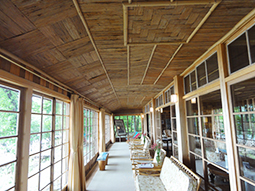 |
|
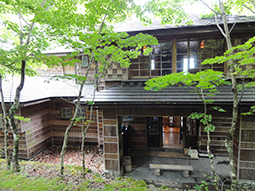 |
|
|
|
A glassed-in veranda brings in views of the lake and mountains; use of cedar bark ties the building to its surroundings. |
Lake Chuzenji is the highest-altitude lake in Japan, located deep in the mountains above Nikko in Tochigi Prefecture. For half a century beginning around 1880, the area surrounding the lake was a fashionable summer resort for Western diplomats and dignitaries, complete with trout fishing, afternoon tea parties, and even a yacht club. By the late 1920s, more than 40 lakefront villas had been built for foreign residents. Of the few that remain today, the most striking is the former summer residence for the Italian ambassador, designed by Antonin Raymond (1888-1976). Built entirely of local materials, the two-story wooden structure is a unique combination of Western and Japanese architecture that blends in beautifully with its scenic surroundings.
|
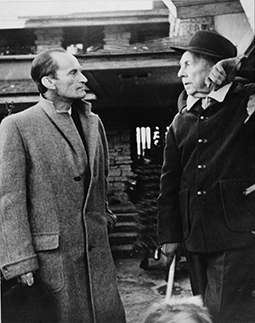 |
|
|
|
Antonin Raymond (left) with Frank Lloyd Wright at Taliesin, 1917. Photo courtesy of Raymond Architectural Design Office Inc. |
Raymond was born in 1888 in Bohemia, which is now part of the Czech Republic. At university he came across photographs of buildings designed by Frank Lloyd Wright and became determined to meet the famous American architect. In 1910 Raymond moved to New York, initially working on the high-rise buildings that were changing the city's skyline. A few years later he got his introduction to Wright, and in 1919 was invited to Tokyo to help Wright build the Imperial Hotel. Raymond worked for over a year on the project, but gradually became disillusioned with Wright's design, which he felt was overly decorative and lacking in any connection with Japan or its traditions.
In 1921 Raymond broke with Wright but stayed in Japan, setting up his own office in Tokyo. For a period of several years he experimented with concrete and austere exteriors devoid of ornamentation, but found it difficult to free himself from Wright's influence. It was only when he started on the design for the Italian ambassador's summer residence, he later wrote, that he found his own style. Today Raymond is often cited as a "father of Japanese modern architecture," not only because he received a great number of important commissions in Japan both before and after World War II, but also because he trained and mentored so many young Japanese architects. Kunio Maekawa (1905-86) and Junzo Yoshimura (1908-97), for example, both worked for Raymond early in their careers, and went on to become key figures in modern Japanese architecture.
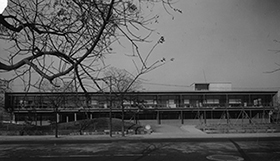 |
|
 |
|
|
|
Two of Raymond's designs: the Reader's Digest Offices, Tokyo (1951), and the Gunma Music Center (1961). Photos courtesy of Raymond Architectural Design Office Inc. |
The Italian Embassy Villa was Raymond's first attempt at a wooden structure, and he looked to traditional Japanese architecture for inspiration. Hoping to learn from local craftsmen and traditions, he wrote the following instruction directly on the blueprint: "All structural materials shall not be decided now as it is advisable to use appropriate local materials at the job. Contractor shall submit samples for approval."
It was a smart move. Nikko is full of temples and shrines, including the lavish Toshogu Shrine, built in 1619 as a shogun's final resting place and now a UNESCO World Heritage site. The constant need for upkeep on these wooden buildings provided steady employment for generations of carpenters, meaning Raymond had access to highly skilled crews. His contractor introduced him to cedar bark, readily available and used in the area for roofing. Raymond was so taken with the rough, expressive material that he decided to use it not only on the exterior walls but for the interior as well. This extensive use of a local, natural material makes the building feel very much part of its surroundings.
 |
|
The ajiro-ori ceiling of woven bark delineates spaces within the open floor plan. |
Because the villa was to be used for entertaining as well as summer quarters for the ambassador and his family, Raymond opted for few interior dividers on the first floor. Such an open floor plan was highly unusual at the time, but allowed for a good flow of guests as well as uninterrupted views of the lake. A large party space in the center is flanked by a dining area on one side and the ambassador's study on the other. Stone fireplaces at either end, constructed in a traditional tamaishi design, provided heat as well as a pleasing overall symmetry.
The most outstanding feature of the villa, by far, is the stunning ceiling over the first-floor space, which is made of strips of cedar bark woven together into intricate and varied patterns. Such wickerwork ceilings, called ajiro-ori, are often seen in traditional Japanese architecture, particularly for the small, intimate teahouses used for hosting tea ceremonies, but it was novel to put such a ceiling in an otherwise Western-style residence. What's more, Raymond used the ceiling to good effect in delineating the separate areas within the open space, using a complex kikko (tortoise-shell) pattern over the center, and simpler patterns over the dining area and study space, including ichimatsu (checkered) and yabane (herringbone) designs.
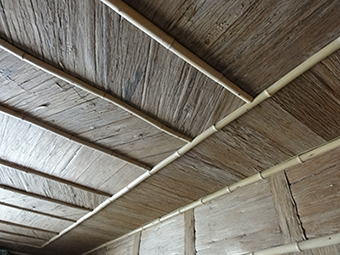 |
|
 |
|
|
|
Wall and ceiling surfaces were constructed by skilled Japanese craftsmen using local materials, including cedar bark and bamboo, and traditional patterns.
Photographs by Alice Gordenker, unless otherwise specified, with permission from Tochigi Prefecture.
|
The villa was used by successive Italian ambassadors for many decades, but eventually, as jet travel became the norm, Lake Chuzenji fell out of fashion with the diplomatic set. Many of the Western-style villas around the lake were closed and fell into disrepair. In 1997, ownership of the Italian Embassy villa was transferred to Tochigi Prefecture, which undertook a two-year restoration, stripping the building to its foundation and rebuilding it completely. A second building on the property, originally used for servants and nearly as charming as the villa itself, has been converted into a mini-museum with exhibits about the area's heyday as a resort. Don't miss the 16-mm film shot in 1929 of foreign diplomats racing each other across the lake, blindfolded, in wasen, a traditional Japanese boat with a single rear sculling oar.
Getting to the villa is a bit of an adventure, particularly by public transportation. From Tokyo, take either JR East trains to JR Nikko station, or the private Tobu Railway from Asakusa to adjacent Tobu Nikko station. Transfer at either station to a Tobu bus in the direction of Yumoto Onsen and ride about 45 minutes to the Chuzenji Onsen bus terminal. From there, it's a 45-minute walk to the villa. During peak tourist periods (July through August, and October through November), a seasonal bus to Hangetsusan will drop you at the "Itaria taishi besso kinen koen iriguchi" stop. It's a 10-minute walk from there. If you're going by car, park at the Utagahama parking lot and hike in about 10 minutes along the path by the lake.
 |
| | Italian Embassy House Memorial Park (in Japanese only) |
| | 2482 Chugushi, Nikko City, Tochigi Prefecture
Phone: 0288-55-0880 (Nikko Natural History Museum)
Hours: 9 a.m. to 4 p.m., April-June and September-November; 9 a.m. to 5 p.m., July and August. Closed Mondays in April, May and November, except on national holidays, when closed the following day. |
|
 |
 |
Alice Gordenker
is a writer and translator based in Tokyo, where she has lived for more than 16 years. In addition to writing about the Japanese art scene she pens the "So, What the Heck Is That?" column for The Japan Times, which provides in-depth reports on everything from industrial safety to traditional talismans. She also writes about early Japanese photography. |
|
 |
|